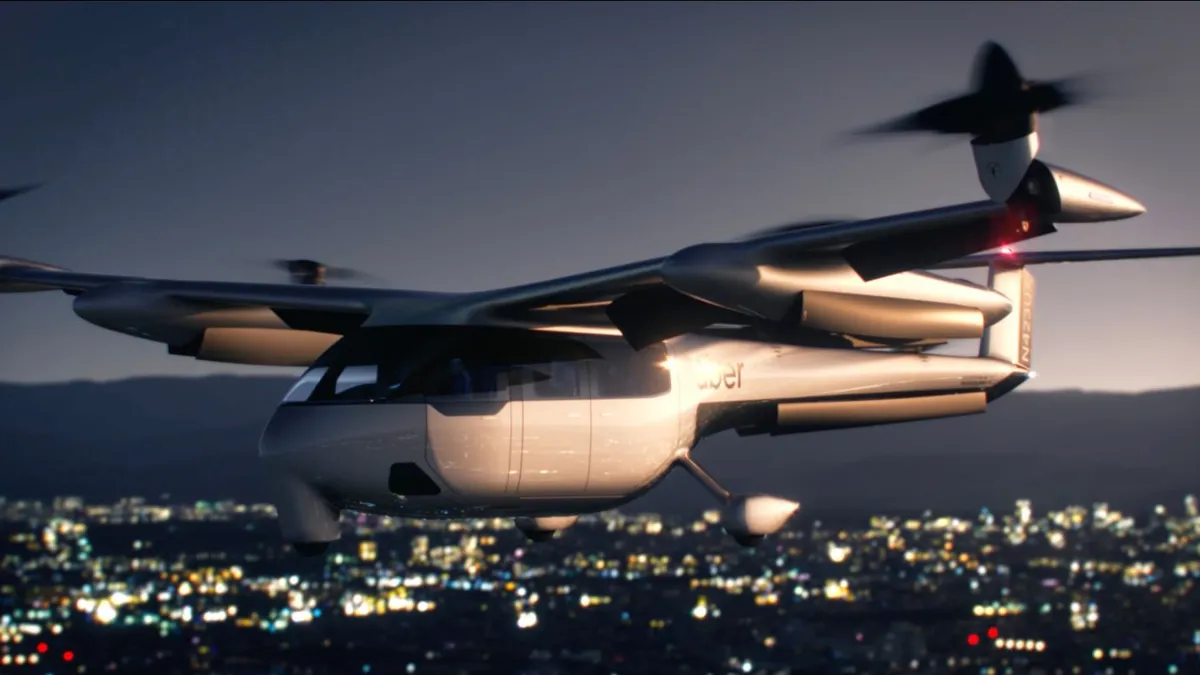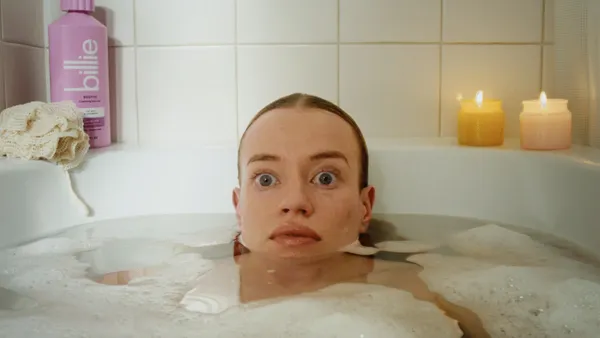Campaign Trail is our analysis of some of the best and worst new creative efforts from the marketing world. View past columns in the archives here.
At sunset in San Francisco, a copter's propellers begin to spin as the passenger-filled vehicle gently lifts off an elevated platform. Soon, the helicopter-plane hybrid soars over congested roadways and lands atop a skyscraper's landing pad. The scene mirrors a futuristic sci-fi film, but is, in reality, a commercial for Uber Elevate's air taxi innovation — a service that doesn't yet exist.
Dubbed "Airborne," the 100-second spot delivers a cinematic vision of the transportation darling's upcoming aerial mass transit concept, seeding viewers' minds for a product that's still four years from launch. The ad, which is entirely computer-generated (CG), was developed by Cannes Mobile Grand Prix winner Bipolar Studio and aims to lay the groundwork for Uber's holistic transportation vision, the studio's founder and Creative Director Gevorg Karensky told Marketing Dive.
"Most commercials reveal a product or trigger an emotion that connects with the product. But in this case, we're showcasing the bigger concept of our future and what could be a shift in how we think of transportation and our lives, along with our sense of time and distance," he said. "The challenge was around science fiction becoming reality and how to best visualize a concept that doesn't yet exist."
Making sci-fi a reality
The campaign for Uber Elevate debuted just one month after Uber's initial public offering and amid a leadership restructuring that saw the departure of its CMO earlier this month. While the IPO fell short of analyst expectations, the company has seen a jump in brand value since 2018, according to a recent Brand Z ranking shared with Marketing Dive. Its fresh, forward-looking campaign for Uber Elevate could be an attempt to reignite excitement around the company's vision for the future.
"Airborne," which debuted at the Uber Elevate Summit in Washington, D.C., on June 11, accompanies a four-minute virtual reality (VR) experience that gives viewers a glimpse of what an Uber Air flight might feel like once the service launches in 2023. Still images and social content round out the campaign's media mix, per a company announcement shared with Marketing Dive.
Before Bipolar Studio could begin assembling the "Airborne" video, the team built a fully digital clone of San Francisco, complete with cars, people and recognizable buildings and landmarks from the city. Including these seemingly minute details instills a stronger sense of place for viewers, Karensky said. The team worked with Uber engineers to ensure the assets' accuracy, from the wind gusts and physics of the flight simulation to the frequency of propellers' rotation. The same data Uber's engineers used for constructing the vehicle prototype went into developing the campaign, Karensky said.
"We had to place ourselves in the future and start with daydreaming of what this technology will be like, based on sci-fi and our imaginations, then figure out how to document that visualization," he said. "We then sketched thumbnails and ideas that started as small as a grain of rice that eventually grew into bigger concepts."
Ultimate creative freedom
Once the CG city was complete, Karensky's team set out to reuse the digital assets to begin assembling "Airborne." Pulling inspiration from car commercials and Apple ads, the team scouted the virtual San Francisco to capture video shots — akin to how traditional ads are planned frame by frame — by essentially placing a CG camera anywhere in the digital city. About 1,700 computers were required to crunch out renderings of the city to make the completed video look like it was shot with a real camera.
"It allowed us to see San Francisco from a very different perspective and have the creative freedom to literally point the camera anywhere and shoot," he said.
"The challenge was around science fiction becoming reality and how to best visualize a concept that doesn't yet exist."

Gevorg Karensky
Bipolar Studio, founder and creative director
While digitizing an entire city required round-the-clock work since February, technical restrictions and the promise of ultimate creative freedom drove the decision to take the virtual route, Karensky said, noting that traditional filming requires ideal lighting, weather, camera mounting and dozens of takes. Uber and Bipolar Studio initially discussed filming city scenes in a traditional manner and overlaying a CG aircraft, as real in-flight shots of the copter aren't yet possible. That strategy came with enough restrictions to drive the team to opt for the more "creatively freeing process," per Karensky.
"Airborne" and the VR experience has racked up more than 75,000 views on YouTube and social media, as of press time.
The next 4 years
While the CG strategy allowed for significant creative freedom, a Bipolar Studio representative says the campaign represents Uber Elevate's plans as they stand today, though the air taxi prototype may change before its scheduled 2023 launch. The team worked with engineers, lawmakers and consultants from NASA and the Federal Aviation Administration to ensure the VR experience and "Airborne" clip's accuracy.
"We think of this an evolution Stage 2 so we don't mislead consumers," Karensky said.
Uber Elevate's installation is slated for a roadshow at conferences and events around the globe to give consumers a taste of the future as the company makes a bet on marketing its longer-term concepts to drive excitement around the brand.















